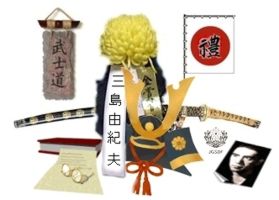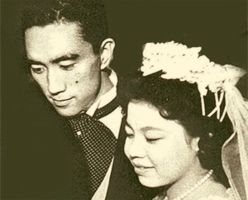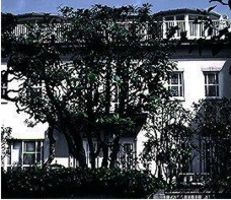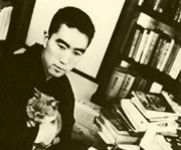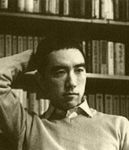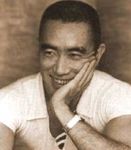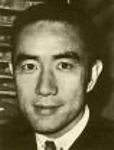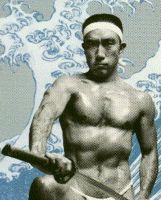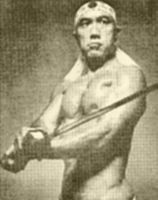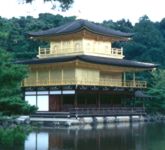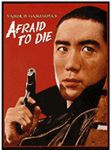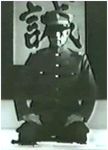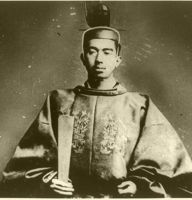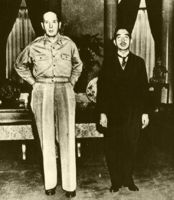| Makoto | Hagakure | Ukiyo | Seppuku | Zen | Kamikaze | Yakuza |
| Shinto | Tatenokai | Tanaka | Jibakutai | Jieitai | Mishima | Chu Hsi |
![]()
1970 BUSHIDO: MISHIMA YUKIO
I don't think that Mishima loved the crowd he used to hang out with, regardless of what some so-called 'art historians' say, except when the crowd was in the role of an audience to his whatever -- speech, for instance. His circle of existence consisted of just himself. He never had any close friend, and no pupil either; what he got was a large bunch of acquaintances, a number of pen-pals, a band of 'groupies', and most of Japan as his fandom. Plus a steady correspondent in the person of Nobel Laureate Kawabata Yasunari, whose writings are too different in everything from Mishima's that a comparison between them is not even sane to attempt. Nothing in that spiritual seclusion is weird; writers and artists in general are like Mishima there. A large number of them have also been as much of exhibitionists as Mishima always was, mentally and physically; he wasn't as eccentric as some insist to maintain. His sharply compartmentalized life of 45 years -- there were a family sphere (Mishima had two kids), a private space, and a public appearance that never got overlapped -- isn't odd, since most public figures, or the species that my fellow- Indonesians call 'celebrities', keep exactly the same mode of operation.
Like most 'celebs', Mishima, too, put on a larger-than-life mask whenever he got out of his door. Hence he was, to the intrigued caucasians he knew, somewhat fun to be with. These people found him very attractive, even if tourists and expats have always been too quick to come to such a conclusion since 1452 until this minute -- any Asian who speaks their language(s), is talkative, and shows some 'knowledge' of their stuff (lifestyle, 'arts', and so forth), has been seen as beyond other Asians, whose racial preference is to brush shoulders with them as minimally as possible.
Now here comes the yummiest part of the Mishima parcel for his audience: though half of him was some plain rural DNA, the other half was Matsudaira. His scary grandma gave him the dose of samuraihood. Incurably snobbish and unreasonably partial, like most Asians always are, the grandma and Mishima's dad shoved the boy into schools which were beneath the kid's intellectual power, simply because his mates there had their clan names registered forever in history books. One of Mishima's 'close friends' in High School, for instance, was Tokugawa Yoshiyasu.
It was typical that Mishima spent much time after his 30th birthday at gyms and dojos because he used to be physically unfit until then. Besides body-building, he also learned as much karate as he could, and swordsmanship. Once the spartan workout showed visible results, his narcism stretched itself to include that of the body, too. That's why you'd always see some pix of Mishima taken for the Playboy, in any book and at any site about him.
Well, it's true that you'd never again see a novelist brandishing swords that he could really cut your head with. The sensation created by such exhibitionism was predictably great, although redundancy slushed the magic down the drain after some time. Yet, even by the time people was reduced to just lift an eyebrow and say "What's Mishima up to now?", the Playboy pix and such revived the interest in the messy tidbits caucasians took to be 'the Japanese culture' and 'the way of the warrior'. Mishima Yukio, by himself, was a tourist attraction. He went to the U.S. and got his books translated and published there; his superficiality concocted for public perusal helped the sale.
Mishima's writings, too, were compartmentalized. His first great novel, the 'very literary' Confessions of a Mask (Kamen no Kokuhaku, 1949) was followed by similarly-accoladed works such as The Sound of Waves (Shiosai, 1954), The Temple of the Golden Pavillion (Kinkakuji, 1956), Rokumeikan (1957), After the Banquet (Utage no Ato, 1960), The Sailor Who Fell from Grace with the Sea (Gogo no Eiko, 1963), Spring Snow (Haru no Yuki, 1968), The Temple of Dawn (Akatsuki no Tera, 1970), The Decay of the Angel (Tennin Gossui, 1970). He also released kabuki plays all the same time, plus launching another sort of books like Literary Discussion of Life (Bungakuteki Jinseiron, 1954), Lectures on Immoral Education (Fudotoku Kyoiku Koza, 1959), Daiichi no Sei-Dansai Kenkyu Koza (The First Studies of Male Sexuality, 1964), The Book of Anti-Chaste Wisdom (Han-Teijo Daigaku, 1965), Mishima Yukio's Letter-Writing Class (Mishima Yukio Reta Kyoshitsu, 1968). Mishima also wrote movie scenarios, directed and starred in them.
Still in the exact same span he published the kind of books such as Can a Modern Novel be a Classic? (Gendai Shosetsu wa Koten Tariuru ka?, 1957), Music (Ongaku, 1965), Fragmentary Reflections on Art (Me-Aru Geijutsu Danso, 1965), The Face of Art (Geijutsu no Kao, 1967), On Man and Literature (Taidan-Ningen to Bungaku, 1968), On Defense of Culture (Bunka Boeiron, 1969), Essays on Authors (Sakkaron, 1970). And he also kicked these tomes belonging to one more genre to circulation: Sword (Ken, 1963), Patriotism (Yukoku, 1966), Voices of the Heroic Dead (Eirei no Koe, 1966), Discussion on the Japanese People (Taiwa-Shin Nihonjin Ron, 1966), Introduction to Hagakure (Hagakure Nyumon, 1967), Sun and Steel (Taiyo to Tetsu, 1968), For Young Samurai (Wakaki Samurai no tame ni, 1969), The Heart of Martial Spirits (Shobu no Kokoro, 1970), On Action (Kodogaku Nyumon, 1970).
The energy he had was apparently well-managed to propel such a gaga-inducing range of interests. Or was it such? Because in a sense all those books (which are only examples here; all his career he published 295 books, 77 of which have been anglicized) were all similar: they were born out of Mishima Yukio's personal aestheticism. 'Aesthetic' as in 'beauty', that is, just in case you happen to be one of the zealous adherents of the so-called 'Contemporary Art', which has no such a notion in its lexicon. Mishima had always been like the young monk he created, who burned Kyoto's Golden Pavillion precisely because he loved the thing so much (browse the novel yourself). He kept on mentioning Ruth Benedict's legendary tome The Chrysanthemum and the Sword (1946), as the writer was able to get the correct portrait of the Japanese soul according to Mishima; but Mishima's own approach to everything in this Milky Way was thru aesthetics, even when the subject was martial arts, sex, sado-masochism, narcism, 'morals', and so on. This doesn't mean that he wasn't serious about anything. Some 'historians' say that Mishima Yukio was only serious about his novels, half-serious with his plays, even less with essays, and not at all in martial arts -- that's really a mindless guess. Perhaps you've never met anybody like him, and maybe you never will; but this fact doesn't mean that there is no such a person on your planet who could do a vastly different things in a variety of interests with equal enthusiasm and ability in each.
Anyway, Mishima Yukio has been wrongly immortalized for his 'Right-Wing Politics', and this, too, persists until today no matter what, since his essays on Bushido stressed the fact, and the last words he said before he died were "Tenno Heika Banzai!" ("Long Live the Emperor!"; that meant Hirohito, because 'Tenno Heika' means 'the Emperor who is on the throne right now'). Mishima was never a political mammal, all his life. He still wasn't political when he loudly advertised himself as one. Politics was absolutely absent from half of his works, and appeared in several gigabytes but unclearly in the other half; his interest in political stuff was for the 'beauty' of it, like, worshipping the Emperor as the son of the Goddess of the Sun. For this, he went into much-publicized debates and mutual enmity with the kabuki company he worked with, as well as with the union of writers and the creatures named 'critics', plus student bodies which trend was Leftist. The same Mishima had some fights against the Right-Wingers, too, because he, in different books and different occasions, attacked the Imperial House, even suggested that Emperor Hirohito (1901-1989) should do better to abdicate so that he could reflect upon the grave sin of World War II that took so many lives of his people. His later view of the Emperor, told many times after he decided to take this Meijian Shintoist creed up (click here if you have no idea what I'm talking about), was even aesthetic, and not political: "His Majesty sat there through the ceremony," Mishima said, "for hours, without even moving a muscle until it was over. That is majestic. It's beautiful."
So was he inconsistent? No, he was consistent all the time. His focus was the aesthetic of such things; what did he care if he bashed both the Left and the Right and even the 'Neutral' zone? Japan was not what it is today, in Mishima's times. He grew up watching one political disaster and the next and the next -- the attempts at coup d'etat by this and that military bands, the coming and going of Cabinets, the atomic bombs, the draft (which he dodge, taking advantage of the fact that he was really ill at the time), the shameful defeat and the devastating no-rearmament aftermath. Probably those numbed him somewhat so that he acquired the typically middle-class impolitical attitude smoothly. Yet, the 47 Ronins stayed in Mishima's mind and refused to fly away since his mom took him to see the play; so did his grandma's 'brainwashing' reminders that he was partially belonging to the warrior class in this militarily hopeless postwar Japan. It mattered that he owned an authentic 16th century sword, forged by one of the masters in the Warring States ('Sengoku') era, Seki Magoroku.
|
|||||||||||||||||||||||||||||||||||||||||
| Previous
Page: Truest Bushido Heroes |
NEW Black Dragon Society |
Next
Page: The Shield Society |
|
Site & Rap © 1996, 1997, 1998, 1999, 2000, 2001, 2002, 2003, 2004, 2005, 2006 Nina Wilhemina
All rights reserved. Every borrowed image at this site is put for non-profit educational purposes only.
HOME
 LINKS
LINKS
 CONTACT
CONTACT
 CREDITS
CREDITS
 COMMENTS
COMMENTS
Sources tapped for this page: Nihon Shakai no Kazoku teki Kosei (Tokyo: 1948); Kono Shozo, Kokumin Dotoku Yoron (Tokyo: 1935); Anesaki Masaharu, Nichiren, the Buddhist Prophet (Cambridge, Mass.: Harvard University Press, 1916); Robert Cornell Armstrong, Light from the East, Studies of Japanese Confucianism (University of Toronto, Canada, 1914); Sasama Yoshihiko, Nihon kassen zuten (Yuzankaku, 1997); William Aston, Shinto: The Way of the Gods (London: Longmans, Green, 1905); Ruth Benedict, The Chrysanthemum and the Sword (Boston: Houghton Mifflin, 1946); Charles Eliot, Japanese Buddhism (London, 1935); Futaki Kenichi, Chuusei buke no saho (Yoshikawa Kobunkan, 1999); Kiyooka Eichii, The Autobiography of Fukuzawa Yukichi (Tokyo, Hokuseido Press, 1934); Konno Nobuo, Kamakura bushi monogatari (Kawade shobo shinsha, 1997); Nukariya Kaiten, The Religion of the Samurai (London: Luzac, 1913); A.L. Sadler, The Beginner's Book of Bushido by Daidoji Yuzan (Tokyo: Kokusai Bunka Shinkokai, 1941); A.L. Sadler, The Makers of Modern Japan (Tokyo: Tuttle, 1978); Satomi Kishio, Nichirenism and the Japanese National Principles (NY: Dutton, 1924); Suzuki D.T., Zen Buddhism and Its Influence on Japanese Culture (Kyoto: The Eastern Buddhist Society, 1938); Henri Van Straelen, Yoshida Shoin (Leiden: Brill, 1952); Robert Bellah, Tokugawa Religion; Sato Hiroaki, Legends of the Samurai (Overlook Press, 1995); Masaaki Takahashi, Bushi no seiritsu: Bushizo no soshutsu (Tokyo: Tokyo daigaku, 1999); Stephen Turnbull, Samurai Warlords (London: Blandford Publishing, 1992); Paul Akamatsu, Meiji 1868, Revolution and Counter-Revolution (Allen & Unwin, 1972); Nitobe Inazo, Bushido, The Soul of Japan (Tokyo: Tuttle, 1970); Paul Varley and Ivan Morris, The Samurai (Weidenfeld, 1970); Inoguchi and Nakajima, The Divine Wind: Japanese Kamikaze Force in World War II (Hutchinson, 1959), Seki Yukihiko, Bushi no tanjo (Tokyo: NHK, 2000); Amino Yoshihiko, ed. Edojidai no mikataga kawaruho (Tokyo: Yosensha, 1998). |
